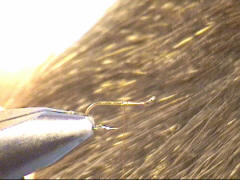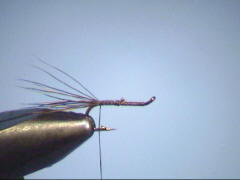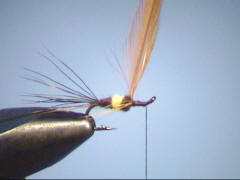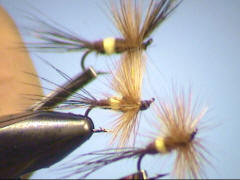|
Flies for All Fish
Joe Cornwall has been fly fishing and tying flies and jigs for well over 30 years. He authored the award-winning book Fly fishing Warm Water Rivers which can be found at www.flyfishohio.com. Joe is a member of the Outdoor Writers of America and the Outdoor Writers of Ohio. He won the 2004 and 2005 OWO award for Best Outdoor Magazine Column for his work in Country Anglin’ Outdoor Guide. A smallmouth bass fanatic at heart, Joe is happy to fish for anything with fins. In this monthly column Joe will share the patterns he’s found to work best in our local waters and for our local game fish. |
|
![]()
Volume 7, Issue 6
June 2006
The Steelhead Bee
Fly and Text by Joe Cornwall
Photography and Video Production by Jim Stuard
Roderick Haig-Brown was an English-born gentleman angler who moved to the banks of the Campbell River in British Columbia in 1936. He lived there until his death in 1976. An important and active conservationist during a time in history when such a voice was almost unheard of, Haig-Brown’s refined abilities as a writer have forever set him apart from those who toil to communicate the joy of fishing in words. Roderick Haig-Brown truly was an artist who defined the concept of “renaissance man.”
Haig-Brown created many fly patterns for winter and summer run B.C. steelhead, as well as patterns designed for the native cutthroat trout, silver salmon and king salmon that lived in the rivers he fished. One such fly is the Steelhead Bee, a pretty little dry fly that Roderick purportedly used to take a 20lb. steelhead during a time when all rods were split cane and all reels featured a simple click-pawl type drag. That was no small accomplishment!
Although there is precious little opportunity for dry fly fishing for steelhead in Ohio, and absolutely none on the waters near Cincinnati, such was the affect of Haig-Brown’s tales on this flyfisher that I wanted nothing more than to see this fly float upon flowing waters. Scaled down and slightly modified to Midwestern conditions, I wasn’t surprised when I found the Steelhead Bee to be quite an effective pattern on bluegill, smallmouth and largemouth bass.
When the big bluegills are on the beds and taking top-water presentations, this is my favorite fly to cast. I may never fish the Campbell River, nor am I likely to present a dry fly to a steelhead. But I’ve seen this fly float, and its beauty and pedigree are nearly as haunting as its design is effective. If you hit the water in June or July to fish for panfish, take a few of these flies with you and see if they conjure the magic of wild places for you, too.
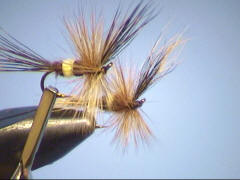 …click
on picture for larger view
…click
on picture for larger view
MATERIALS
Hook – Mustad 94840 or 94842 up-eye Dry Fly Hook, size 10 to 14
Thread – Brown 8/0 (70 denier)
Tail – Dark moose body fur, stacked and cleaned
Body – Alternating bands of brown, yellow, and brown Spirit River
dry fly dubbing
Wings – Dark moose body fur, stacked and cleaned and tied forward over the hook eye
Hackle – Brown
TYING STEPS …click on picture for larger view
|
1. Mount the hook in the vise and start your thread just behind the eye. Wrap the thread to the bend of the hook and then back to the mid-point in preparation for the tail |
|
|
2. Cut and clean a small bunch of moose body hair. Measure so the tail extends past the bend of the hook a distance equal to the hook gape. Tie in the tail at the mid-point of the hook. Use progressively looser wraps as you approach the bend of the hook to keep the hair from flaring. |
|
|
3. If you decide to use a wing, now is the time to tie it in. This fly produces just as well when tied as a “variant” pattern — that is a dry fly pattern tied with a hackle but without a wing. That is the way it is tied in the accompanying video. When I use a wing, I like to use moose body hair. Cut and clean a stack of moose twice the thickness of the tail. Measure so it extends one hook shank length beyond the eye of the hook and tie it in so it extends in front of the hook eye at a 45 degree angle. The wing is placed this way to facilitate skating the fly on moving water. |
|
|
4. Bring the thread back to the bend of the hook at the tail tie-in point. Dub a body in three parts using brown, yellow and brown Antron dry fly dubbing. The original called for seal dubbing. |
|
|
5. Tie in a high quality dark brown hackle. I like a coachman brown, but you can also use ginger, furnace or fiery brown. For a more “buggy” effect you can also use one brown and one grizzly hackly like an Adams. |
|
|
6. Wrap a thick hackle collar. I like to use about 8 to 10 turns of hackle. This fly will have to stand up to a lot of abuse and, hopefully, a lot of fish. I like to twitch the fly gently, so a heavily hackled, high floating tie is good insurance that it will stay on the surface. You should also treat this fly with Campdry or a similar silicone floatant to help with buoyancy. |
Till next time, tight lines and gentle breezes…

